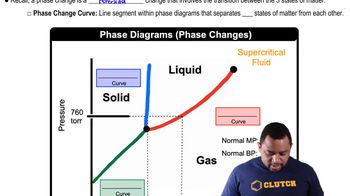A 5.00-L vessel contains 25.0 g of PCl3 and 3.00 g of O2 at 15 °C. The vessel is heated to 200.0 °C, and the contents react to give POCl3. What is the final pressure in the vessel, assuming that the reaction goes to completion and that all reactants and products are in the gas phase?

Verified Solution
Key Concepts
Ideal Gas Law

Stoichiometry of the Reaction

Gas Phase Reactions

When 10.0 g of a mixture of Ca(ClO3)2 and Ca(ClO)2 is heated to 700 °C in a 10.0-L vessel, both compounds decompose, forming O2(g) and CaCl2(s). The final pressure inside the vessel is 1.00 atm. (a) Write balanced equations for the decomposition reactions.
A steel container with a volume of 500.0 mL is evacuated, and 25.0 g of CaCO3 is added. The container and contents are then heated to 1500 K, causing the CaCO3 to decompose completely, according to the equation CaCO3(s) → CaO(s) + CO2(g). (a) Using the ideal gas law and ignoring the volume of any solids remaining in the container, calculate the pressure inside the container at 1500 K.
A steel container with a volume of 500.0 mL is evacuated, and 25.0 g of CaCO3 is added. The container and contents are then heated to 1500 K, causing the CaCO3 to decompose completely, according to the equation CaCO3(s) → CaO(s) + CO2(g). (b) Now make a more accurate calculation of the pressure inside the container. Take into account the volume of solid CaO (density = 3.34 g/mL) in the container, and use the van der Waals equation to calculate the pressure. The van der Waals constants for CO2(g) are a = 3.59 (L2-atm)/mol2 and b = 0.0427 L/mol.
